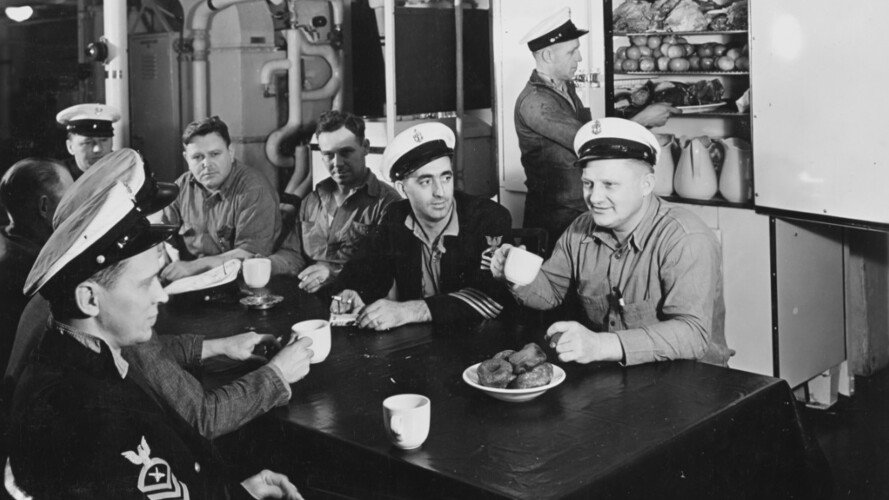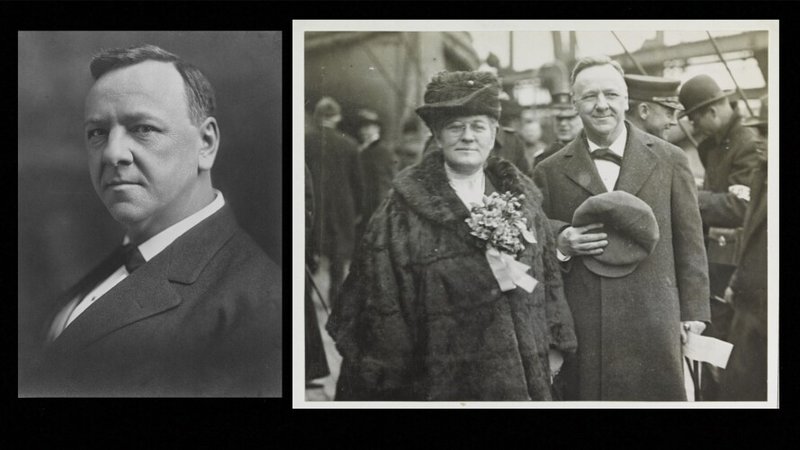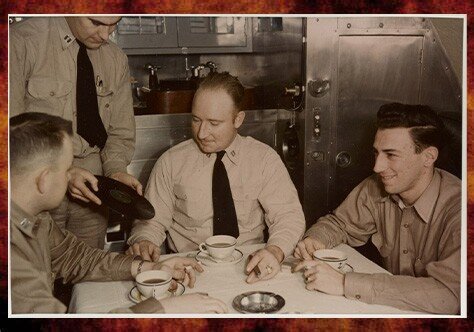
Coffee break in the Chief Petty Officers' mess, Jan. 18, 1938, on board the light cruiser Brooklyn. US Naval History and Heritage Command photo.
The next time you tell your barista you’d like a cup of joe, you might thank an early-20th-century Navy secretary for the handy phrase.
Although the debate over the phrase's origins is as hot as you probably like your java, the term "cuppa joe" likely stems from Navy Secretary Josephus Daniels and his infamous General Order 99, which banned booze on board all ships and in all yards and stations worldwide in 1914.
As the linguistic theory goes, disgruntled Navy and Marine Corps officers took to downing their coffee — a poor substitute for their barred wine mess — in a lamentful nod to their civilian boss, Daniels. The term first appeared in print in 1932 in the US Navy’s Reserve Officer’s Manual.
The US Naval History and Heritage Command credits Daniels for inspiring the phrase, and so does Lee A. Craig, a distinguished professor of economic history at North Carolina State University and the author of the 2013 biography, Josephus Daniels: His Life and Times.
“My original title for Daniels’ biography was ‘Cup-A-Joe: The Life and Times of Josephus Daniels,’” Craig told Coffee or Die Magazine. “My editor rejected it, because, as you note, there are competing claims for the origin of that expression. I like my version, and I’ll leave it at that.”

Navy Secretary Josephus Daniels, shown here with his wife, the suffragette Adelaide “Addie” Worth Bagley, on board the troopship Leviathan, just before sailing for France in late 1918. US Naval History and Heritage Command photos.
The US Navy didn’t become dry overnight.
On March 27, 1794, the Continental Congress established a daily ration for sailors of "one half-pint of distilled spirits,” and if that wasn’t available, “one quart of beer.”
On June 15, 1831, Navy Secretary Levi Woodbury issued a general order that allowed servicemen to swap the daily liquor ration for a payment of six cents — about $2 today. The payment would fluctuate alongside adjustments to the amount and type of hooch that was poured out until Feb. 3, 1899.
That’s when Navy Secretary John D. Long banned the sale or issue of "any malt or alcoholic liquor” to enlisted sailors and Marines, “except in the medical department," thereby making Doc the most popular man in the battalion or on board ship.
During World War I, Daniels and Congress tightened the Navy’s stranglehold on alcoholic beverages by not only outlawing the officers’ wine mess but also banning the sale of booze to service members in uniform, plus creating tavern-free “dry zones” in communities within 5 miles of bases.

Berth deck cooks in 1887 on board the sloop-of-war Ossippee, complete with coffee cups and a bearded US Marine. Photo by E.H. Hart, now in the collections of the US Naval History and Heritage Command.
While liquor slowly became Navy contraband, the fleet sailed the globe on a sea of coffee. In 1842, the Navy added coffee and cocoa to the daily ration. Like cigarettes and cigars, java starred on holiday menus.
But thanks to Navy cooks, it often wasn’t the best tasting drink.
“The present method of making coffee is for the berth-deck cook to drop an uncertain amount of ground coffee into a big tin bucket and pour a still more uncertain amount of hot water over it,” Albert Parker Niblack wrote in an 1891 US Naval Institute essay. “The coffee steeps for 10 or 20 minutes, and the result is an insipid drink in which a great amount of excellent coffee has literally gone to pot.”
Retiring as a three-star admiral, Niblack drank a lot of craptacular Navy joe in a career that spanned nearly five decades and included campaigns in the Philippines, Mexico, and World War I.
But by the time he died in 1929, the US Navy straddled the globe, a modern and professional maritime service that would prove its mettle a dozen years later at the start of World War II.
And the primary architect for the rise of US naval power was “cup-a-joe” himself, Josephus Daniels, the Navy secretary for Woodrow Wilson between 1913 and 1921.

On board on the battleship New York in 1916, from left: inventor Thomas A. Edison, Navy Secretary Josephus Daniels, and Adm. Henry T. Mayo, with members of the scientific consulting board standing behind them. US Naval History and Heritage Command photo.
A landlubber who never served a day in uniform, Daniels brought women into the Navy and Marine Corps; established service schools on board ships and at stations; championed naval aviation; opened up the US Naval Academy to enlisted sailors; and made sure the fleet during World War I helped defeat the U-boat menace and maintained a steady stream of troops to Europe, where the weight of American might crushed Germany in 1918.
Not bad for a kid born poor in a North Carolina ravaged by the Civil War, who rose to prominence as a press baron and Democratic politico.
A Progressive Era crusader against child labor and business monopolies, the wealthy publisher was also an unrepentant white supremacist who’d led campaigns to re-segregate both the military and Southern society.
Daniels championed women’s suffrage and yet toiled tirelessly to deny the ballot to Black Americans. He hated imperialism but presided over a gunboat Navy that exerted US power across the Caribbean, Mexico, Central America, and China.

Decades removed from the commissioned officers’ wine mess, these World War II submarine officers examine a phonograph record while enjoying coffee and smokes in their boat’s wardroom. US National Archives photo.
Daniels believed in temperance, religious liberty, good public schools and infrastructure, a free press, and a fair shake for the working man.
But he also helped lead the only successful coup d’etat in US history, the Wilmington insurrection of 1898 that removed from power a biracial government elected by its citizens.
“Thucydides admonishes us about the quest for the truth,” said Daniels’ biographer, Craig. “Every generation will have its own standards for judging the present and the past. Today, we don’t view the history of debates on, say, the tariff, the same way we do race. Even by the standards of his own day, Daniels was on the wrong side of that. He was never apologetic about his views or who he was. He was who he said he was. So, one cannot absolve him of those views.”
“Although, today, we view Daniels’ ‘Progressive’ goals as being in conflict, he would not have seen them that way,” Craig continued. “In his day, Daniels could claim that white supremacy was a form of political progress, because disenfranchising Black voters removed them from politics and therefore from the gridlock that surrounded key issues at the time, such as, to offer just one example, public school funding.”

From left: Secretary of the Navy Josephus Daniels, Paymaster General Rear Adm. Samuel McGowan, and Assistant Secretary of the Navy Franklin D. Roosevelt. US Naval History and Heritage Command photo.
While he helmed the Navy, Daniels brought aboard as his apprentice a young New York patrician who also hadn’t served in uniform, Franklin D. Roosevelt.
As Craig points out in his book, Daniels might’ve been the only boss FDR ever had, a man the future president initially viewed as a hillbilly but later came to call “chief.”
The fleets and air squadrons Daniels inspired and began to build became FDR’s tools to conquer Germany, Italy, and Japan during World War II.
“Although they were very different men in regional and social background, education, and temperament, they did have a few important things in common: ambition, a commitment to the success of the Democratic Party, an extraordinary capacity for mental and physical demands of politics in their day, and an uncomplicated patriotism that revolved around what they thought was good for their country,” Craig told Coffee or Die. “What they had in common dominated their differences, and they were a good team.”
Read Next: Check Out This Chinese-Russian Flotilla in the Bering Sea

Carl Prine is a former senior editor at Coffee or Die Magazine. He has worked at Navy Times, The San Diego Union-Tribune, and Pittsburgh Tribune-Review. He served in the Marine Corps and the Pennsylvania Army National Guard. His awards include the Joseph Galloway Award for Distinguished Reporting on the military, a first prize from Investigative Reporters & Editors, and the Combat Infantryman Badge.
BRCC and Bad Moon Print Press team up for an exclusive, limited-edition T-shirt design!
BRCC partners with Team Room Design for an exclusive T-shirt release!
Thirty Seconds Out has partnered with BRCC for an exclusive shirt design invoking the God of Winter.
Lucas O'Hara of Grizzly Forge has teamed up with BRCC for a badass, exclusive Shirt Club T-shirt design featuring his most popular knife and tiomahawk.
Coffee or Die sits down with one of the graphic designers behind Black Rifle Coffee's signature look and vibe.
Biden will award the Medal of Honor to a Vietnam War Army helicopter pilot who risked his life to save a reconnaissance team from almost certain death.
Ever wonder how much Jack Mandaville would f*ck sh*t up if he went back in time? The American Revolution didn't even see him coming.
A nearly 200-year-old West Point time capsule that at first appeared to yield little more than dust contains hidden treasure, the US Military Academy said.












